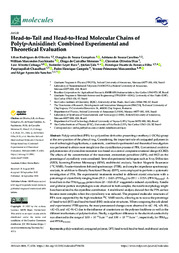Head-to-tail and head-to-head molecular chains of poly(p-anisidine): Combined experimental and theoretical evaluation.
Head-to-tail and head-to-head molecular chains of poly(p-anisidine): Combined experimental and theoretical evaluation.
Author(s): OLIVEIRA, L. R. de; GONÇALVES, D. S.; CAROLINO, A. S.; FACCINATTO, W. M.; MENEZES. D. C.; DIAS, C. O.; COLNAGO, L. A.; RUIZ, Y. L.; IU, S. T.; FONSECA FILHO, H. D.; CHAUDHURI, P.; CAMPELO, P. H.; MASCARENHAS, I. P.; SANCHES, E. A.
Summary: : Poly(p-anisidine) (PPA) is a polyaniline derivative presenting a methoxy (?OCH3) group at the para position of the phenyl ring. Considering the important role of conjugated polymers in novel technological applications, a systematic, combined experimental and theoretical investigation was performed to obtain more insight into the crystallization process of PPA. Conventional oxidative polymerization of p-anisidine monomer was based on a central composite rotational design (CCRD).The effects of the concentration of the monomer, ammonium persulfate (APS), and HCl on the percentage of crystallinity were considered. Several experimental techniques such as X-ray Diffraction(XRD), Scanning Electron Microscopy (SEM), multifractal analysis, Nuclear Magnetic Resonance(13C NMR), Fourier-transform Infrared spectroscopy (FTIR), and complex impedance spectroscopyanalysis, in addition to Density Functional Theory (DFT), were employed to perform a systematic investigation of PPA. The experimental treatments resulted in different crystal structures with a percentage of crystallinity ranging from (29.2 ± 0.6)% (PPA1HT) to (55.1 ± 0.2)% (PPA16HT-HH). A broad halo in the PPA16HT-HH pattern from 2θ = 10.0?30.0◦suggested a reduced crystallinity. Needle and globular-particle morphologies were observed in both samples; the needle morphology might have been related to the crystalline contribution. A multifractal analysis showed that the PPA surface became more complex when the crystallinity was reduced. The proposed molecular structures of PPA were supported by the high-resolution 13C NMR results, allowing us to access the percentage of head-to-tail (HT) and head-to-head (HH) molecular structures. When comparing the calculated and experimental FTIR spectra, the most pronounced changes were observed in ν(C?H), ν(N?H), ν(C?O), and ν(C?N?C) due to the influence of counterions on the polymer backbone as well as the different mechanisms of polymerization. Finally, a significant difference in the electrical conductivitywas observed in the range of 1.00 × 10−9 S.cm−1 and 3.90 × 10−14 S.cm−1, respectively, for PPA1HT and PPA16HT-HH.
Publication year: 2022
Types of publication: Journal article
Unit: Embrapa Instrumentation
Keywords: Conjugated polymer, Multifractal analysis, Poly(p-anisidine)
Observation
Some of Embrapa's publications are published as ePub files. To read them, use or download one of the following free software options to your computer or mobile device. Android: Google Play Books; IOS: iBooks; Windows and Linux: Calibre.
Access other publications
Access the Agricultural Research Database (BDPA) to consult Embrapa's full library collection and records.
Visit Embrapa Bookstore to purchase books and other publications sold by Embrapa.

